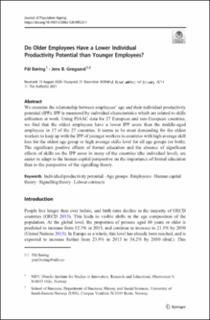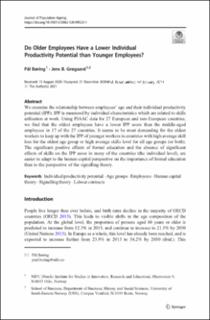| dc.contributor.author | Børing, Pål | |
| dc.contributor.author | Grøgaard, Jens Brandi | |
| dc.date.accessioned | 2022-09-02T08:02:27Z | |
| dc.date.available | 2022-09-02T08:02:27Z | |
| dc.date.created | 2021-01-02T21:22:31Z | |
| dc.date.issued | 2021 | |
| dc.identifier.citation | Journal of Population Ageing. 2021, . | |
| dc.identifier.issn | 1874-7884 | |
| dc.identifier.uri | https://hdl.handle.net/11250/3015306 | |
| dc.description.abstract | We examine the relationship between employees’ age and their individual productivity potential (IPP). IPP is measured by individual characteristics which are related to skills utilisation at work. Using PIAAC data for 27 European and non-European countries, we find that the oldest employees have a lower IPP score than the middle-aged employees in 17 of the 27 countries. It seems to be most demanding for the oldest workers to keep up with the IPP of younger workers in countries with high average skill loss for the oldest age group or high average skills level for all age groups (or both). The significant positive effects of formal education and the absence of significant effects of skills on the IPP score in many of the countries (the individual level), are easier to adapt to the human capital perspective on the importance of formal education than to the perspective of the signalling theory. | |
| dc.language.iso | eng | |
| dc.title | Do older employees have a lower individual productivity potential than younger employees? | |
| dc.type | Peer reviewed | |
| dc.type | Journal article | |
| dc.description.version | publishedVersion | |
| dc.description.version | acceptedVersion | |
| dc.source.pagenumber | 29 | |
| dc.source.journal | Journal of Population Ageing | |
| dc.identifier.doi | 10.1007/s12062-020-09323-1 | |
| dc.identifier.cristin | 1864342 | |
| dc.relation.project | Norges forskningsråd: 255210 | |
| cristin.ispublished | true | |
| cristin.fulltext | original | |
| cristin.fulltext | postprint | |
| cristin.qualitycode | 1 | |

